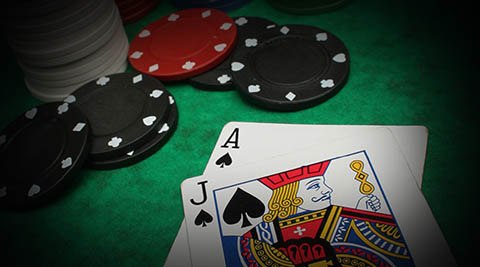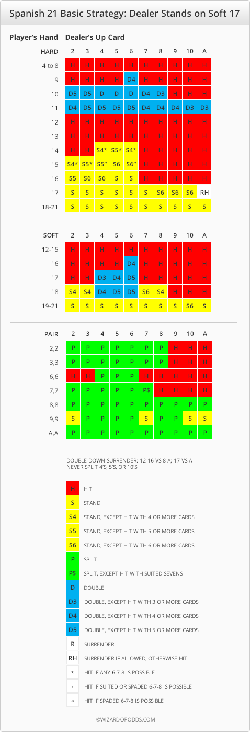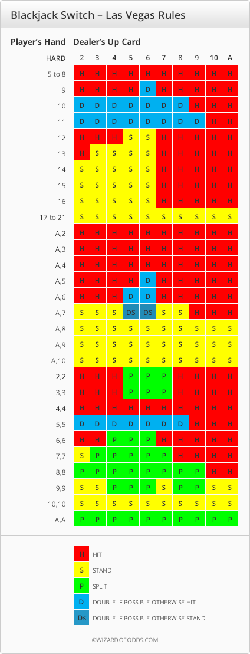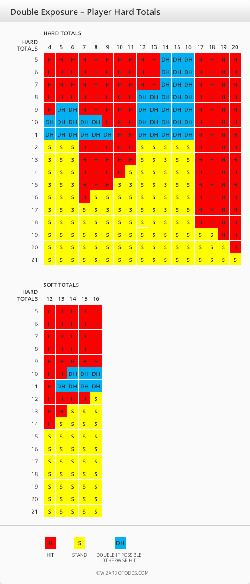
|
| « Articles | History of Playing Cards | Gallery of Playing Cards | Card Games Rules | CONTACT |
Strategies for Popular Blackjack Variations
Blackjack, also popularly referred to as twenty one, is the most widespread casino banking game in the world. Though it is unclear exactly where Blackjack originated from, its first written reference dates back to Spain in a 1602 short story by Miguel Cervantes, best known for his classic Don Quixote. In the 17th century its popularity exploded in French Casinos, and was later introduced in the United States in the 1800s where, in order to promote the new game and entice new players, casino’s offered a 10 to 1 payout to any player who coupled an Ace of Spades with a jack of spades or jack of clubs: A black jack. The name has stuck ever since.

Since its introduction in America, 21 is referred to most popularly as ‘Blackjack’.
Though the 10 to 1 bonus payout was eventually replaced by a 3 to 2 payout regardless of the card’s suits, this would certainly not be the last time that the game’s payouts or rules would be modified in order to attract players. The game’s popularity has led casino game developers to create a countless amount of Blackjack variants across the years, each out flaunting unique features meant to change the gameplay and odds considerably, luring players to test their skills and attempt to beat the house.
Since there are certainly more variations out there than can possibly be mentioned, this article will focus on helping you find the best strategy when playing the three of the most interesting and popular Blackjack variants in the world.
Spanish 21
The main difference between regular Blackjack and Spanish 21 comes from the latter being played with 6 or 8 48-card Spanish decks, rather than the usual 52-card decks. The difference between the two: The Spanish deck removes the four 10s.
As is expected, removing the 10s is in no way an advantage for the players,-quite the opposite in fact as it extends the house edge to approximately 2%. So why would anyone want to play this Blackjack variant? Simple: In compensation, Spanish 21 offers much more liberal rules that can be exploited with the proper strategy.
The following are some of the advantages you receive in Spanish 21:
- Player Blackjack or 21 will ALWAYS win against the house, even if the dealer has the same hand.
- Player can double with 3 cards or more
- Players are only allowed to split once
- Late Surrenders are allowed
- Doubling after split is allowed
- Hitting and Doubling after splitting aces is allowed
- Re-splitting aces is allowed (to a maximum of four hands)
- Player may surrender after doubling down, rescuing original wager.
- Low card 21s have special payouts
- 5-card 21 – 3 to 2
- 6-card 21 – 20 to 1
- 7 cards or more 21 – 3 to 1
- A 6-7-8 or 7-7-7 of mixed suits pays 3 to 2, of the same suit pays 2 to 1, and of spades pays 3 to 1
- Suited 7-7-7 when the dealer has a seven face up pays $1000 for bets of $5-$24 and $5000 for bets of $25.
 While these rules apply in the majority of land based or online casinos, make sure to check the rules before you play. It’s important that you adapt your strategy to take into consideration the decrease of 10s in the deck as well as all the rule variations in your favor, rather than play with your tried and true blackjack strategy. Below you will see an updated chart reflecting how you should modify your play in Spanish 21.
While these rules apply in the majority of land based or online casinos, make sure to check the rules before you play. It’s important that you adapt your strategy to take into consideration the decrease of 10s in the deck as well as all the rule variations in your favor, rather than play with your tried and true blackjack strategy. Below you will see an updated chart reflecting how you should modify your play in Spanish 21.
BlackJack Switch
One of the most interesting variations to be created in the last decade, Blackjack Switch was invented and patented in 2009 by a former card counter called Geoff Hall. Hall had often found himself being dealt 2 weak hands and wishing he could exchange the top cards of each to make his hands stronger. It was with this thought in mind that he created Blackjack Switch.
Unlike regular Blackjack each position has two betting boxes rather than one, as players will be playing two hands at once. Making identical initial wagers for each hand, player will be dealt two separate hands that he can choose to hit, double, split or stand independently of each other, or he can choose to switch the top cards or each before acting individually.
In order to compensate for this advantage, the house has introduced the following modifications to regular blackjack rules:
- A dealer 22 will push against every player hand, except Blackjack
- Dealer Blackjacks push against player Blackjacks
- Winning player Blackjacks pay even money
- A Blackjack that result from a switch will count as a 21
- Dealer usually hits a soft 17
Strategy for Blackjack Switch is two fold: The strategy for switching and the strategy for playing each hand, based on the variant of a Dealer 22 pushing.
The first decision you will have to make upon being dealt both hands is whether or not to switch the top cards. The rule of thumb for making this decision is to maintain or preserve the best single hand, however this oversimplified strategy is not always reliable.
Optimal play will depend on what card the dealer is showing. Against a dealer 7 or 8, the ideal strategy is to balance the hands by making the weaker hand as high as possible. Against any other dealer card, try and maximize the strength of the higher card.
 Finally, once the decision to switch is out of the way, let’s go over the basic strategy for playing each individual hand as illustrated in the chart below:
Finally, once the decision to switch is out of the way, let’s go over the basic strategy for playing each individual hand as illustrated in the chart below:
Double Exposure BlackJack
Knowing the dealer’s hand has is the name of the game in Double Exposure Blackjack, where both dealer cards are facing upwards- letting players know what the hand to beat is. This is a fantastic advantage to the players and one that has made this a very popular game among blackjack enthusiasts. In order to compensate for this advantage however, players can expect the regular Blackjack rules to be altered as follows:
- Dealer wins all ties, except on a natural Blackjack.
- Blackjacks pay even money
- Players are only allowed to split once
- Insurance is not available (as both cards will be exposed from the start)
In addition to these rules, the following house rules may apply as well – varying in different casinos:
- Dealer hits on soft 17
- Player may not be able to double after a split
- Player can only split once
- Player can only split identical face cards
While these rules tip the house edge to be larger than other variants, the advantage of knowing the dealers hand, coupled with smart strategic play, can result in high levels of profitability.
 In the chart below, you will find the basic strategy to follow for betting when the dealer will stand on soft 17:
In the chart below, you will find the basic strategy to follow for betting when the dealer will stand on soft 17:
Conclusion
Spanish 21, Blackjack Switch, and Double Exposure Blackjack are all fantastic, innovative options if you are looking to shake up your Blackjack play and by trying something different. That being said, make sure to follow the basic strategy guides to adapt your play to each game variation, or you will find yourself missing out on taking advantage of the perks of each game, or suffering from the drawbacks of not preparing for the rules meant to compensate for the house.